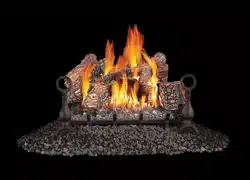Loading ...
Loading ...
Loading ...

W415-0809 / D / 02.26.21
EN
22
troubleshooting
11.0 troubleshooting
27.4
symptom problem test solution
Flames are consistently too
large or too small.
Carboning occurs.
Appliance is over-fi red or
underfi red.
- Check pressure readings:
Inlet pressure can be checked by turning screw (A) counter-clockwise
2 or 3 turns and then placing pressure gauge tubing over the test
point. Gauge should read as described on the chart below. Check that
main burner is operating on ‘HI’. Outlet pressure can be checked the
same as above using screw (B). Gauge should read as described on
the chart below. Check that main burner is operating on ‘HI’. AFTER
TAKING PRESSURE READINGS, BE SURE TO TURN SCREWS
CLOCKWISE FIRMLY TO RESEAL. DO NOT OVER TORQUE.
Leak test with a soap and water solution.
Air shutter improperly adjusted. - Return air shutter to specifi ed opening, see “venturi adjustment” section.
Carbon is being deposited
on glass, logs, rocks,
media or combustion
chamber.
Air shutter has become blocked. - Ensure air shutter opening is free of lint or other obstructions.
Flame is impinging on the
glass, logs, rocks, media or
combustion chamber.
- Check that the logs are correctly positioned.
- Check for ceiling or oscillating fans that may be infl uencing the fl ame.
- Open air shutter to increase the primary air. See “venturi adjustment”
section.
- Check the input rate: check the manifold pressure and orifi ce size as
specifi ed by the rating plate.
Exhaust fumes smelled in
room, headaches.
Not enough combustion air. - Increase fresh air supply. (Use one of the methods described in ANSI
Z223.1 / NFPA 54 or the applicable local code.)
Not enough ventilation air. - Increase fresh air supply. (Use one of the methods described in ANSI
Z223.1 / NFPA 54 or the applicable local code.)
Flame is impinging on the logs or
combustion chamber.
- Check that the logs are correctly positioned.
- Open air shutter to increase the primary air. See “venturi adjustment”
section.
- Check the input rate: check the manifold pressure and orifi ce size as
specifi ed by the rating plate values.
Main burner will not light;
or is slow to light, noisy
pilot.
Inlet pressure too high. - Adjust inlet pressure to ensure 7.0” W.C. (17.4mb) at gas valve for
natural gas and 13.0” W.C. (32.4mb) for propane.
Pilot fl ame blowing off, missing
thermopile.
Pilot is not functioning
properly.
Pilot has been painted - Using a piece of sandpaper or emery cloth remove the paint from the
pilot hood, ignitor and fl ame sensor.
Pilot goes out while
standing; Main burner is in
‘OFF’ position.
Gas piping is undersized. - Turn on all gas appliances and see if pilot fl ame fl utters, diminishes or
extinguishes, especially when main burner ignites. Monitor appliance
supply working pressure.
- Check if supply piping size is to code.
- Correct all undersized piping.
Pilot fl ame is not large enough. - ODS Burner requires checking.
INSERT
PHOTO
OF VALVE
HERE
Pressure
Natural Gas
(inches)
Natural Gas
(millibars)
Propane
(inches)
Propane
(millibars)
Inlet
* 7”
(MIN. 4.5”)
17.4mb
(MIN. 11.2mb)
13”
(MIN. 11”)
32.4mb
(MIN. 27.4mb)
Outlet
3.5” 8.7mb 10” 24.9mb
* Maximum inlet
pressure not to
exceed 13”
• Always light the pilot whether for the fi rst time or if the gas supply has run out with the glass door open or removed.
• Turn off the appliance completely and let cool before servicing. Only a qualifi ed service person should service and
repair this electric appliance.
• Appliance may be hot, do not service until appliance has cooled.
• Do not use abrasive cleaners.
!
WARNING
Loading ...
Loading ...
Loading ...
